Al-Madrasah Al-Kamilia
On
El-Mo'ez Street in Bin Al-Qasrain area in front of Bashtak Palace lies the
remains of Al-Madrasah Al-Kamilia built by Sultan El-Malek El-Kamel Nasser
El-Din Mohammad in 662 AH/ 1225 Ad and Amir Hasan Katkhuda during Mohammad Amin
Pasha's era.
Al-Madrasah
Al-Kamilia is the second school for teaching Hadith and Sunnah after the school
established by El-Malek Al-Adel Noor El-Din Zenky in Damascus. El-Malek El-Kamel built El-Madrasah
El-Kamilia to be home to El-Hadith El-Sharif and El-Shafi'i School's scholars.
Al-Madrasah Al-Kamilia consists of a middle courtyard with two
iwans and several rooms for students on both sides. There is nothing left of
this school but the remains of the northern iwan which is covered with a
pointed stone dome. As for the southern iwan, it is now the hanging mosque of
Hasan Katkhuda El-Sharaawy. The mosque is an iwan for the qibla, and it is
divided into three tiles parallel to the wall of the qibla by two marble
columns.
Al-Madrasah Al-Kamilia has a simple entrance
with a triple arch and
thresholds inscribed with a text in the Ottoman language.
It is worth mentioning
that Al-Madrasah Al-Kamilia was known as Dar El-Hadith El-Kamilia because it taught
different sciences of Hadith.
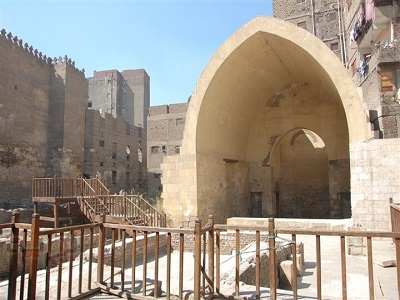

Madrasah of Al-Zaher
Baibars al-Bunduqdari
The Madrasah of Al-Zahir Baibars was built during the
Mamluk era in 660 A.H on El-Mo'ez Street adjacent to El-Saleh Negm El-Din Ayoub
tomb. It is one of the Islamic schools in the Mamluk era. It consists of a
courtyard surrounded by four iwans, and each side has an entrance leads to the
sabil attached to the school, student rooms, and bathrooms. Recently what remains of the school is the
entrance's right side, part of the southern iwan, and the tasbil room of the
sabil. Al-Madrasa Al-Zaheria has a distinctive feature, which is the
inscription of Al-Zaher Baibars rank on its windows, which means panther in the
Turkish language.
It is also written on the western façade of the school
built by the order of Sultan Baibars, El-Malek El-Zaher, in 660 A.H.
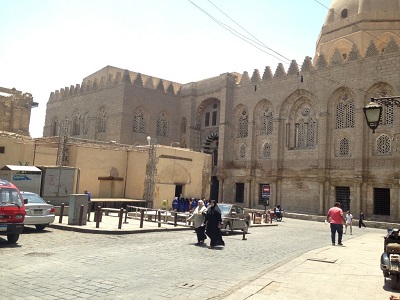
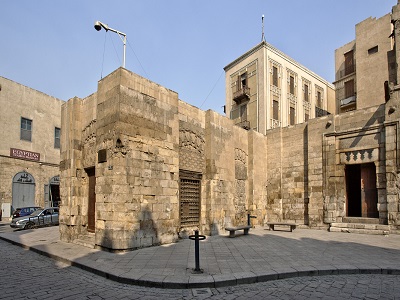
Madrasa of Al-Salih Negm Al-Din Ayyub
The madrasa is located on a distinctive
site on El-Mo'ez le Din Allah Street (Bayn al-Qasrain area). The Madrasa of Al-Salih
Negm Al-Din Ayyub was erected on the site where the Fatimid Eastern Palace once
stood. It was built to teach the four Sunni schools of fiqh (jurisprudence),
and is considered to be the first school built in Egypt for that purpose. Shagarat
Al-Durr, the wife of the sultan, Al-Salih Negm Al-Din, added a mausoleum in
which the sultan was buried in AH 648 / AD 1250.
Thus, an Ayyubid architectural complex was built in
the heart of Fatimid Cairo that offered the city a new architectural style.
Much admired by the Mamluks, the new manner was imitated in the Mamluk
complexes that gradually extended along El-Mo'ez Street, forming the main
artery of the City of Cairo.
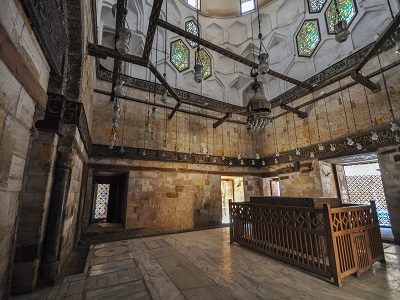
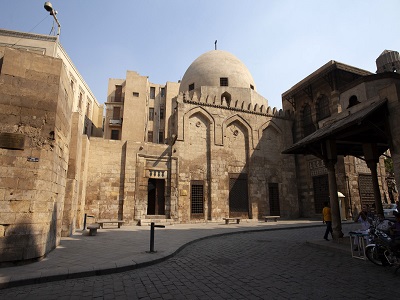
From the beginning of the AH 5th / AD 11th century
the Islamic state participated actively in the building of schools that were
high-level educational foundations aimed at religious instruction according to
the four Sunni Schools of Law (Maliki, Shafi'i, Hanbalii and Hanafii).
The main façade of the madrasa was built from dressed
stone aligned with meticulous attention and composed of a tripartite structure.
In the middle section (the entrance) there is a horizontal band of inscription
carved in the naskhi script which bears the name of the builder and which
offers supplications for him. In the middle of this section, which is
surmounted by a lintel composed of interlocking voussoirs, is an arched niche
ornamented by five rows of muqarnas which crowns the entrance.
The madrasa has a minaret, which rises above the
entrance block indicating the entrance that today leads to the Salehia Alley.
The minaret, built of brick covered with white plaster, is the only remaining
intact minaret of the Ayyubid dynasty.
The minaret is crowned above the octagonal form with
two rows of muqarnas, topped by a lobed dome. This type of minaret is called
al-mabkhara (the incense burner) due to the distinctive octagonal section and
the dome, which crowns it closely, resembling Ayyubid metal incense burners.
This style of minaret continued to be popular up to
the beginning of the Mamluk period, as seen in the minaret of the Khanqah of Baibars
Al-Gashanqir dating to AH 709 / AD 1310.
The plan of the madrasa is composed of two identical
buildings (the schools) which have a single, shared, entranceway and a shared
façade. The entrance leads to a passageway with two opposing doors. The eastern
door leads to the two iwans of the Maliki and Shafi'i Schools, and the western
door leads to the two iwans of the Hanbali and Hanafi Schools.
Source: Discover Islamic Arts Website
Al-Madrasah Al-Ashrafia (Madrasah of
Al-Sultan Al-Ashraf Barsbay)
Al-Madrasah
Al-Ashrafia is located on Al-Mo'ez Street in the heart of Cairo, where many other
unique Islamic monuments and madrasahs exist/ situated like El-Madrasah El-Mansouria,
El-Nahasin Complex, and El-Ghori Complex. The Madrasa of Al-Ashraf Barsbay has
a distinctive and strategic location among these monuments. Al- Madrasah
Ashrafia was named after its owner Al-Sultan El-Malek Al-Ashraf Barsbay
El-Zahery, who built the school on Al-Mo'ez Street.
Al-Madrasah Al-Ashrafia is one of the greatest
Mamluk madrasahs as it reflects one of the Islamic greatest ages, which is the age
of Burji Mamluks (Circassian Mamluks). The madrasah is a charitable building
that includes a sabil to provide fresh water to passersby and a kuttab for
teaching orphans reading and writing as well as the Quran.
Moreover, the madrasah was built for teaching the
four Sunni schools of Islam and Sufism at the same time, and it also served as a
mosque.
Al-Madrasah Al-Ashrafia has the same common
architectural design of the Burji Mamluk era, which consists of a courtyard
surrounded by four iwans, the biggest of which is the iwan of the qibla, mausoleum,
sabil, kuttab, and residence for the school's sheikh. The student dorms are on
the upper floor.
The madrasah is characterized by a façade in the Ablaq
style (an architectural technique involving alternating or fluctuating rows of
light and dark stone). It has two facades; a southeast façade and a northeast
façade. The entrance to the school is on the southern end of the southeast
façade which is designed in the Ablaq style and decorated with the sultan rank (the
sultan's seal).
The entrance leads to a square space with two
arched doors, which lead to a sabil and square vestibule and the courtyard is
at the end of this vestibule and surrounded by four iwans, the biggest of which
is the iwan of the qibla. The qibla iwan is characterized
by marble decorations, wooden minbar, and mihrab. On the left side of the
mihrab, there is minbar decorated with different star patterns.
Furthermore, the madrasah has a square minaret
with a series of muqarnas tiers that carry the first balcony wrapped around the
square shaft of the minaret. At the top of the minaret, there is an
onion-shaped dome crowned by a crescent.


